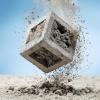
Breaking News
 This roof paint blocks 97% of sunlight and pulls water from the air
This roof paint blocks 97% of sunlight and pulls water from the air
 'Venomous' Republican split over Israel hits new low as fiery feud reaches White House
'Venomous' Republican split over Israel hits new low as fiery feud reaches White House
 Disease-ridden monkey that escaped from research facility shot dead by vigilante mom protecting...
Disease-ridden monkey that escaped from research facility shot dead by vigilante mom protecting...
 Hooters returns - founders say survival hinges on uniform change after buying chain...
Hooters returns - founders say survival hinges on uniform change after buying chain...
Top Tech News
 The 6 Best LLM Tools To Run Models Locally
The 6 Best LLM Tools To Run Models Locally
 Testing My First Sodium-Ion Solar Battery
Testing My First Sodium-Ion Solar Battery
 A man once paralyzed from the waist down now stands on his own, not with machines or wires,...
A man once paralyzed from the waist down now stands on his own, not with machines or wires,...
 Review: Thumb-sized thermal camera turns your phone into a smart tool
Review: Thumb-sized thermal camera turns your phone into a smart tool
 Army To Bring Nuclear Microreactors To Its Bases By 2028
Army To Bring Nuclear Microreactors To Its Bases By 2028
 Nissan Says It's On Track For Solid-State Batteries That Double EV Range By 2028
Nissan Says It's On Track For Solid-State Batteries That Double EV Range By 2028
 Carbon based computers that run on iron
Carbon based computers that run on iron
 Russia flies strategic cruise missile propelled by a nuclear engine
Russia flies strategic cruise missile propelled by a nuclear engine
 100% Free AC & Heat from SOLAR! Airspool Mini Split AC from Santan Solar | Unboxing & Install
100% Free AC & Heat from SOLAR! Airspool Mini Split AC from Santan Solar | Unboxing & Install
 Engineers Discovered the Spectacular Secret to Making 17x Stronger Cement
Engineers Discovered the Spectacular Secret to Making 17x Stronger Cement
Soft Magnets Promise To Make Electric Motors 3 Times Lighter

Energy efficiency – either for electric or ICE cars – is achieved by one of these three pillars: mass, aerodynamics or powertrain. Researchers from the Carnegie Mellon University will be able to tackle two of these pillar at once with a new soft magnetic material they have developed. It would be able to make electric motors up to three or four times lighter. With the same performance.
The technical name of these magnets is "metal amorphous nanocomposite materials". The magic, or else, the science on these soft magnets, is their ability not to heat up as much as common magnetic materials. That allows them to achieve higher RPMs when applied to electric motors.
"The faster you can switch the magnetic material, the faster you can spin the motor, the more power you get out of it," said Michael McHenry, a professor of materials science and engineering that is one of the leading scientists on this research.
"If I can spin the motor at higher and higher speeds, I get more and more power. That means I can use a smaller motor for the same job."
Electric cars have a big problem mass problem with their battery packs, something that could be solved with new battery technology to increase power density, such as the one developed by IMEC. But reducing weight on electric motors is also very welcome.
The main goal of the scientists seems to be developing motors for robots, but electric cars would also benefit from it. Professor McHenry's team is also working on new electric motors designs with an axial flux approach. Similar to the one from Magnax.



